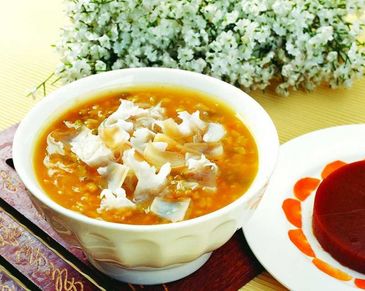中国汉族的传统食物,属于农历新年的应时食品,寓意着年年高升。那么你知道年糕用英语怎么说吗?现在跟学习啦小编一起学习关于年糕的英语知识吧。

年糕英语说法
New Year cake
rice cake
年糕的英语例句
请带走一些年糕吧,想要多少就拿多少!
Please take as much as rice cake you want!
我当然在忙着煎年糕咯!
I certainly busy slightly fried glutinous rice cakes!
我们会吃一些饺子和年糕。
We eat some dumplings and rice cakes.
将年糕和鸡丝入锅。
Return the rice cakes and prepared chicken into wok.
让这种甜蜜的、极富趣味的糯米年糕成为点缀新春佳节的礼赞。
This sweet, fun-to-eat sticky rice cake is as delightful as the festive spirit of the New Year holiday!
中国年糕工业化生产可行性研究
Feasibility Study on Industrialized Production of Chinese New Year Cake
将年糕和鸡丝入锅。
Return the rice cakes and prepared chicken into wok.
请带走一些年糕吧,想要多少就拿多少!
Please take as much as rice cake you want!
她给你做了些年糕。
She made some rice cakes for you.
我也很喜欢吃年糕。
I also like to eat rice cakes.
我多么想蘸着香醋吃些饺子,吃点年糕啊。
wish i could eat some jiaozi in vinegar, and some nian gou.
北方人普遍吃饺子、面条和年糕。
Northerners generally eat dumplings, noodles and rice cakes.
在她们贫穷的家里,一块小小的年糕都是无上的美味了啊。
Being an extremely poor family, a rice cake was the most delicious food.
HACCP系统在年糕生产中的应用研究
Application of HACCP system in rice cakes production
年糕的同音就是“一年更比一年高”,象征着人们的生活一年更比一年好。
Nian Gao is a homonym for “ higher each year ” and symbolizes improvement in life, year by year.
在那一天,人们会向灶神供奉自做的糖果,年糕,红枣和核桃。
On that day, families worship the Kitchen God with offerings of home-made candies, rice cakes, dates and walnuts.
有一天有个男子访问他,得到这种草。于是他把它系好衣服的带上。老翁说自己刚才吃过年糕。
It is said that it can digest a man if an anaconda licks it after it swallows him.
一些男人设法穿过已被破坏的道路,在一个小店里买了些年糕和干李子。
A few men navigated the damaged road and bought rice cakes and dried plums at a small store.
关于年糕的英文介绍:年糕寓意年年高升
In Chinese, niangao sounds like "getting higher year by year". In Chinese people's mind, the higher you are the more prosperous your business is. The main ingredients of niangao are sticky rice, sugar, chestnuts, Chinese dates, and lotus leaves. The Symbolism of Niangao The pronunciation of niangao sounds like 'year high' (年高), which symbolizes a higher income, a higher position, the growth of children, and generally the promise of a better year. Niangao was originally used as an offering in ritual ceremonies before it gradually became a Spring Festival food.
年糕在中文的发音里意味着年年高升。因此中国人总认为,如果一个人官位升的越高,其财富就越多。通常制作年糕的材料有大米,糖,栗子,红枣,还有荷叶。鉴于其谐音寓意年年高升,所以象征在来年着更多的收入,更高的职位,孩子成长得更快。由于年糕最早出现是作为宗教仪式上的贡品,其后逐渐才演变成春节的一款食物。
Lucky Saying for Eating Niangao关于年糕的吉祥话:
年年高 : Getting higher year by year, can imply children's height, business, study, work, etc.
年糕相关英文阅读:春节必备的九大暖心美味食物
Dumplings
饺子
Dumplings are always a popular food in Northern China and often find their way on the table during Spring Festival. Different cooking methods of cooking, such as boiling, frying and steaming can create dumplings with different tastes. Chinese dumplings date back to the Southern and Northern Dynasties (420-581).
饺子是中国北方人们热衷的食物,在春节期间更是餐桌必备。饺子有不同做法,煮、煎、蒸,各俱风味。中国饺子的历史可追溯到南北朝(420-581)时期。
Spring pancake
春饼
It is traditional to eat thin pancakes on the day of the solar term Beginning of Spring. Having a bite of the pancake with fresh vegetables rolled in it means to take in the vigor and energy of spring.
立春吃春饼是传统习俗,一张薄饼卷进新鲜蔬菜,咬一口,意味着汲取了春的生机和活力。
Sweet dumplings
汤圆
Sweet dumplings are often made of white sugar, rose, sesame, sweetened bean paste, nuts and date paste. Because of their round shape, sweet dumplings are always considered a symbol of a good reunion in Chinese culture
汤圆通常由白糖、玫瑰花、芝麻、豆沙、果仁和枣泥制作,因其形状圆满,在中国文化中,汤圆常寓意团圆。
Rice cake
年糕
A rice cake is mainly made of sticky rice. In the past, yellow and white rice cakes symbolized gold and silver. Its pronunciation is similar to "live long" in Chinese, which gives "rice cake" another auspicious meaning.
年糕主要由糯米制成,在过去黄、白年糕象征黄金和白银,年糕与“年高”谐音,寓意吉祥。
Wonton
馄饨
The shape of a wonton bears a resemblance to a shoe-shaped gold ingot that Chinese people used in ancient times, so wonton soup is also called ingot soup. The second day of the first lunar month is the time to worship the God of Wealth, and people have wonton soup to wish for wealth in the New Year.
馄饨与中国古人用的鞋形元宝相似,因此,馄饨汤也叫元宝汤。正月第二天是祭财神的日子,在那天,人们会喝元宝汤以祈愿新一年财运亨通。
Melon-shaped sweets
糖瓜
Made of millet and malt, melon-shaped sweets are very sticky. They are often stored outside of the house to stay crisp in winter.
糖瓜是由小米和麦芽熬制成的粘性很大的糖,为保持松脆,冬天糖瓜常置于室外。
Rice and millet
大小米粥
In North China, people often eat rice and millet that are cooked together during Spring Festival. Yellow millet and white rice also symbolize gold and silver, wealth and fortune in life.
在中国北方春节,人们常喝大小米混合熬制的米粥。黄色的小米和白色的大米象征着金银,寓意着生活中的财富。
Wu Guo soup
五果汤
Wu Guo soup is one of the traditional Cantonese delicacies for the lunar New Year. It is made of coxi seed, gordon euryale seed, dried longan pulp, lotus seed and red bean.
五果汤是广东地区的新年传统美味,主料有薏米、芡实、桂圆、莲子和红豆五种珍果。
Tu Su wine
屠苏酒
Tu Su wine is a kind of medicinal liquor that ancient Chinese consumed on Chinese New Year's Eve. It contains more than seven kinds of traditional Chinese medicine herbs. Sun Simiao, a celebrated doctor in the Tang Dynasty (618-907), promoted Tu Su wine in China. "Tu Su" means to defend from evil and harm and to stay alive.
屠苏酒是古人在除夕喝的一种药酒,含7种多的传统草药,由唐朝(618-907)名医孙思邈推广开来。“屠苏”二字意味着驱邪避害、益寿延年。
